Adaptive Kalman Filter Under Minimum Error Entropy with Fiducial Points for Strap-Down Inertial Navigation System/Ultra-Short Baseline Integrated Navigation Systems
Abstract
1. Introduction
2. Related Work
2.1. Minimum Error Entropy Criterion
2.2. Maximum Correntropy Criterion
2.3. Minimum Error Entropy Criterion with Fiducial Points
2.4. Traditional Kalman Filter
- Time updating:
- 2.
- Measurement updating:
3. Methodology
3.1. Augmented Regression Model
| Algorithm 1: MEEF-KF |
| Step 1: Initialize the state a priori estimate and the corresponding state prediction error covariance matrix ; select two kernel bandwidths and , choose a proper weight factor and a specified small positive value ; Step 2: Utilize Equations (14) and (15) to calculate and , use Cholesky decomposition to get and ; calculate the and ; Step 3: Let and , where is the estimated state at the fixed-point iteration : |
| with: |
| Step 4: if then go to Step 5. else , and return to Step 3. Step 5: Update and compute the posterior error covariance matrix by: |
| and return to Step 2. |
3.2. Free-Parameter Optimization Scheme
| Algorithm 2: AMEEF-KF |
| Step 1: Initialize the state a priori estimate and the corresponding state prediction error covariance matrix ; choose a specified small positive value ; set a nominal weight factor ; Step 2: Utilize Equations (14) and (15) to get and , use Cholesky decomposition to get and ; calculate the and ; Step 3: Construct the error discrimination statistic by Equation (44), calculate the variable kernel bandwidth by Equations (45) and (46), and determine the weight factor by Equation (47); Step 4: Let and , where represents the estimated state at the fixed-point iteration : |
| with: |
| Step 5: if then go to Step 6. else , and return to Step 4. Step 6: Update to and compute the posterior error covariance matrix by: |
| and return to Step 2. |
4. Experiments and Analysis
4.1. Simulation Test
- Gaussian Noise
- 2.
- Bimodal Gaussian Mixture Noises with Outliers
4.2. Experimental Verification
- (1)
- An IMU providing 6-DOF motion perception with a sampling rate of 200 Hz;
- (2)
- A USBL acoustic positioning system (Kongsberg Maritime Inc., Kongsberg, Norway) comprising a surface transceiver and a submerged transponder;
- (3)
- A SPAN-ISA-100C GNSS/INS integrated system (NovAtel Inc., Calgary, AB, Canada) delivering RTK-level positioning accuracy.
5. Discussion
Author Contributions
Funding
Data Availability Statement
Acknowledgments
Conflicts of Interest
References
- Jalal, F.; Nasir, F. Underwater navigation, localization and path planning for autonomous vehicles: A review. In Proceedings of the International Bhurban Conference on Applied Sciences and Technologies (IBCAST), Islamabad, Pakistan, 12–16 January 2021. [Google Scholar] [CrossRef]
- Yang, Y.; Liu, Y.; Sun, D.; Xu, T.; Xue, S.; Han, Y.; Zeng, A. Seafloor geodetic network establishment and key technologies. Sci. China Earth Sci. 2020, 63, 1188–1198. [Google Scholar] [CrossRef]
- Paull, L.; Saeedi, S.; Seto, M.; Li, H. AUV navigation and localization: A review. IEEE J. Ocean. Eng. 2013, 39, 131–149. [Google Scholar] [CrossRef]
- Wang, L.; Pang, S. AUV navigation based on inertial navigation and acoustic positioning systems. In Proceedings of the OCEANS 2018 MTS/IEEE Charleston, Charleston, SC, USA, 22–25 October 2018. [Google Scholar] [CrossRef]
- Morgado, M.; Oliveira, P.; Silvestre, C.; Vasconcelos, J.F. Embedded vehicle dynamics aiding for USBL/INS underwater navigation system. IEEE Trans. Control Syst. Technol. 2013, 22, 322–330. [Google Scholar] [CrossRef]
- Zames, G. Feedback and optimal sensitivity: Model reference transformations, multiplicative seminorms, and approximate inverses. IEEE Trans. Autom. Control 2003, 26, 301–320. [Google Scholar] [CrossRef]
- Cappé, O.; Godsill, S.J.; Moulines, E. An overview of existing methods and recent advances in sequential Monte Carlo. Proc. IEEE 2007, 95, 899–924. [Google Scholar] [CrossRef]
- Gustafsson, F.; Gunnarsson, F.; Bergman, N.; Forssell, U.; Jansson, J.; Karlsson, R.; Nordlund, P. Particle filters for positioning, navigation, and tracking. IEEE Trans. Signal Process. 2002, 50, 425–437. [Google Scholar] [CrossRef]
- Psiaki, M.L.; Schoenberg, J.R.; Miller, I.T. Gaussian sum reapproximation for use in a nonlinear filter. J. Guid. Control Dyn. 2015, 38, 292–303. [Google Scholar] [CrossRef]
- Alspach, D.; Sorenson, H. Nonlinear Bayesian estimation using Gaussian sum approximations. IEEE Trans. Autom. Control 1972, 17, 439–448. [Google Scholar] [CrossRef]
- Chang, L.; Li, K.; Hu, B. Huber’s M-estimation-based process uncertainty robust filter for integrated INS/GPS. IEEE Sens. J. 2015, 15, 3367–3374. [Google Scholar] [CrossRef]
- Karlgaard, C.D. Nonlinear regression Huber–Kalman filtering and fixed-interval smoothing. J. Guid. Control Dyn. 2015, 38, 322–330. [Google Scholar] [CrossRef]
- El-Hawary, F.; Jing, Y. Robust regression-based EKF for tracking underwater targets. IEEE J. Ocean. Eng. 1995, 20, 31–41. [Google Scholar] [CrossRef]
- Zhang, T.; Wang, J.; Zhang, L.; Guo, L. A student’s T-based measurement uncertainty filter for SINS/USBL tightly integration navigation system. IEEE Trans. Veh. Technol. 2021, 70, 8627–8638. [Google Scholar] [CrossRef]
- Huang, Y.; Zhang, Y.; Xu, B.; Wu, Z.; Chambers, J. A new outlier-robust student’s t based Gaussian approximate filter for cooperative localization. IEEE/ASME Trans. Mechatron. 2017, 22, 2380–2386. [Google Scholar] [CrossRef]
- Roth, M.; Özkan, E.; Gustafsson, F. A Student’s t filter for heavy tailed process and measurement noise. In Proceedings of the 2013 IEEE International Conference on Acoustics, Speech and Signal Processing, Vancouver, BC, Canada, 26–31 May 2013. [Google Scholar] [CrossRef]
- Wang, G.; Chen, B.; Yang, X.; Peng, B.; Feng, Z. Numerically stable minimum error entropy Kalman filter. Signal Process. 2021, 181, 107914. [Google Scholar] [CrossRef]
- Chen, B.; Dang, L.; Gu, Y.; Zheng, N.; Príncipe, J.C. Minimum error entropy Kalman filter. IEEE Trans. Syst. Man. Cybern. Syst. 2019, 51, 5819–5829. [Google Scholar] [CrossRef]
- Chen, B.; Liu, X.; Zhao, H.; Principe, J.C. Maximum correntropy Kalman filter. Automatica 2017, 76, 70–77. [Google Scholar] [CrossRef]
- Izanloo, R.; Fakoorian, S.A.; Yazdi, H.S.; Simon, D. Kalman filtering based on the maximum correntropy criterion in the presence of non-Gaussian noise. In Proceedings of the 2016 Annual Conference on Information Science and Systems (CISS), Princeton, NJ, USA, 16–18 March 2016. [Google Scholar] [CrossRef]
- Chen, B.; Yuan, Z.; Zheng, N.; Príncipe, J.C. Kernel minimum error entropy algorithm. Neurocomputing 2013, 121, 160–169. [Google Scholar] [CrossRef]
- Xie, Y.; Li, Y.; Gu, Y.; Cao, J.; Chen, B. Fixed-point minimum error entropy with fiducial points. IEEE Trans. Signal Process. 2020, 68, 3824–3833. [Google Scholar] [CrossRef]
- Cheng, L.; Ren, M.F.; Xie, G. Multipath estimation based on centered error entropy criterion for non-Gaussian noise. IEEE Access 2016, 4, 9978–9986. [Google Scholar] [CrossRef]
- Heravi, A.R.; Hodtani, G.A. A new robust fixed-point algorithm and its convergence analysis. J. Fixed Point Theory Appl. 2017, 19, 3191–3215. [Google Scholar] [CrossRef]
- Principe, J.C. Information Theoretic Learning: Renyi’s Entropy and Kernel Perspectives, 1st ed.; Springer: New York, NY, USA, 2010; pp. 47–102. [Google Scholar] [CrossRef]
- Chen, B.; Zhu, Y.; Hu, J.; Principe, J.C. System Parameter Identification: Information Criteria and Algorithms, 1st ed.; Elsevier Science Publishers B.V.: Amsterdam, The Netherlands, 2013; pp. 12–26. [Google Scholar] [CrossRef]
- Liu, W.; Pokharel, P.P.; Principe, J.C. Correntropy: Properties and applications in non-Gaussian signal processing. IEEE Trans. Signal Process. 2007, 55, 5286–5298. [Google Scholar] [CrossRef]
- Liu, W.; Pokharel, P.P.; Principe, J.C. Correntropy: A localized similarity measure. In Proceedings of the 2006 IEEE International Joint Conference on Neural Network Proceedings, Vancouver, BC, Canada, 16–21 July 2006. [Google Scholar] [CrossRef]
- Singh, A.; Principe, J.C. Using correntropy as a cost function in linear adaptive filters. In Proceedings of the 2009 International Joint Conference on Neural Networks, Atlanta, GA, USA, 14–19 June 2009. [Google Scholar] [CrossRef]
- Chen, B.; Príncipe, J.C. Maximum correntropy estimation is a smoothed MAP estimation. IEEE Signal Process. Lett. 2012, 19, 491–494. [Google Scholar] [CrossRef]
- Liu, W.; Pokharel, P.P.; Principe, J.C. Error entropy, correntropy and M-estimation. In Proceedings of the 2006 16th IEEE Signal Processing Society Workshop on Machine Learning for Signal Processing, Maynooth, Ireland, 6–8 September 2006. [Google Scholar] [CrossRef]
- Kalman, R.E.; Bucy, R.S. New results in linear filtering and prediction theory. J. Basic Eng. 1961, 83, 95–108. [Google Scholar] [CrossRef]
- Kalman, R.E. A new approach to linear filtering and prediction problems. J. Basic Eng. 1960, 82, 35–45. [Google Scholar] [CrossRef]
- Liu, W.; Principe, J.C.; Haykin, S. Kernel Adaptive Filtering: A Comprehensive Introduction, 1st ed.; John Wiley & Sons, Inc.: Hoboken, NJ, USA, 2010; p. 182. [Google Scholar] [CrossRef]
- Varmuza, K.; Filzmoser, P. Introduction to Multivariate Statistical Analysis in Chemometrics, 1st ed.; CRC Press: Boca Raton, FL, USA, 2009; pp. 58–64. [Google Scholar] [CrossRef]
- Wang, B.; Wang, Z. Adaptive robust Kalman filter based on MCC and its application in underwater integrated navigation. In Proceedings of the China Satellite Navigation Conference (CSNC 2022), Beijing, China, 26–28 April 2023. [Google Scholar] [CrossRef]
- Zhao, S.; Yang, Y.; Wang, Z.; Xue, S. Extended joint adjustment of the transducer and seafloor transponder for GNSS-Acoustic seafloor geodetic network positioning with inter-station ranging information. IEEE Sens. J. 2024, 24, 19982–19994. [Google Scholar] [CrossRef]
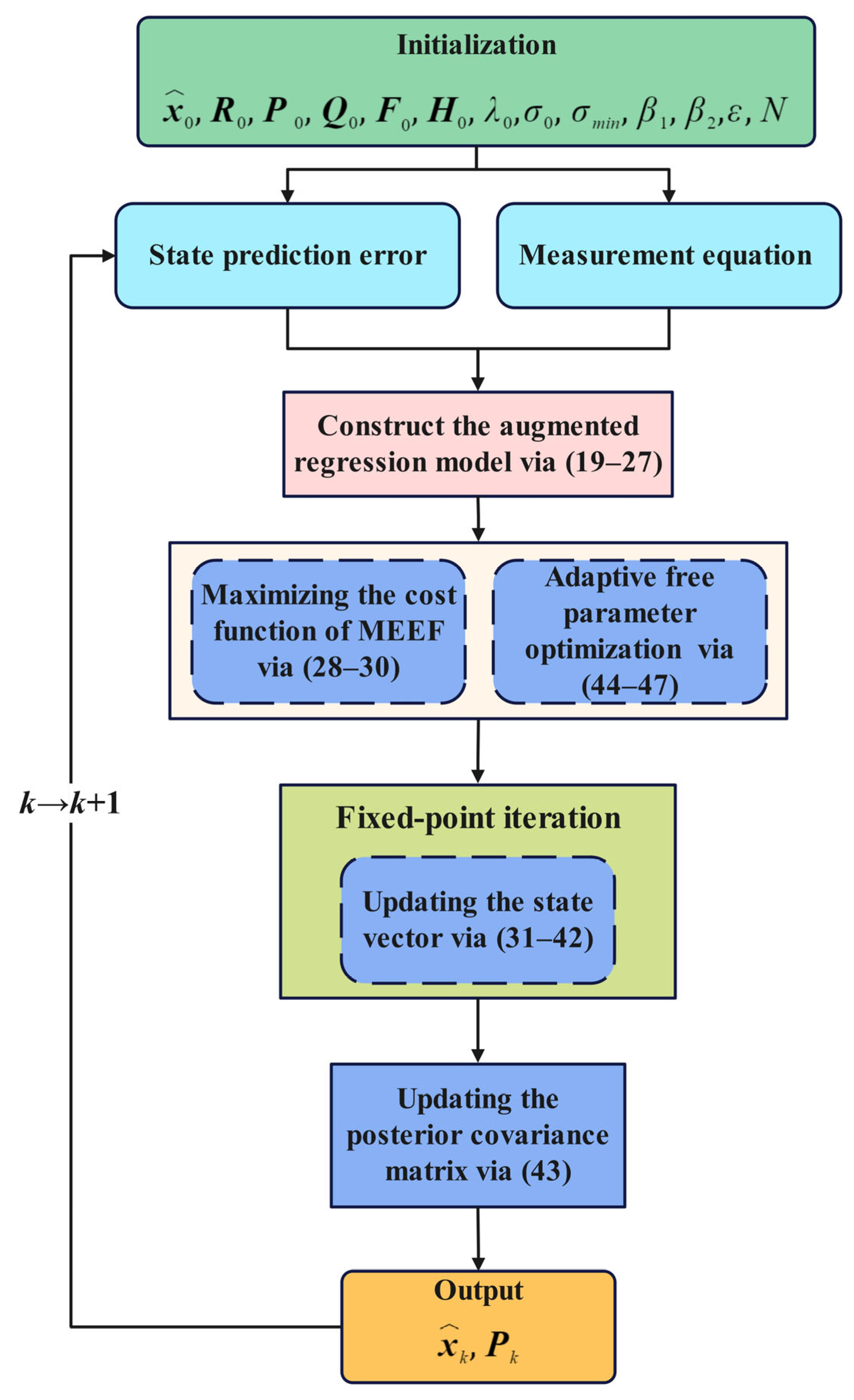
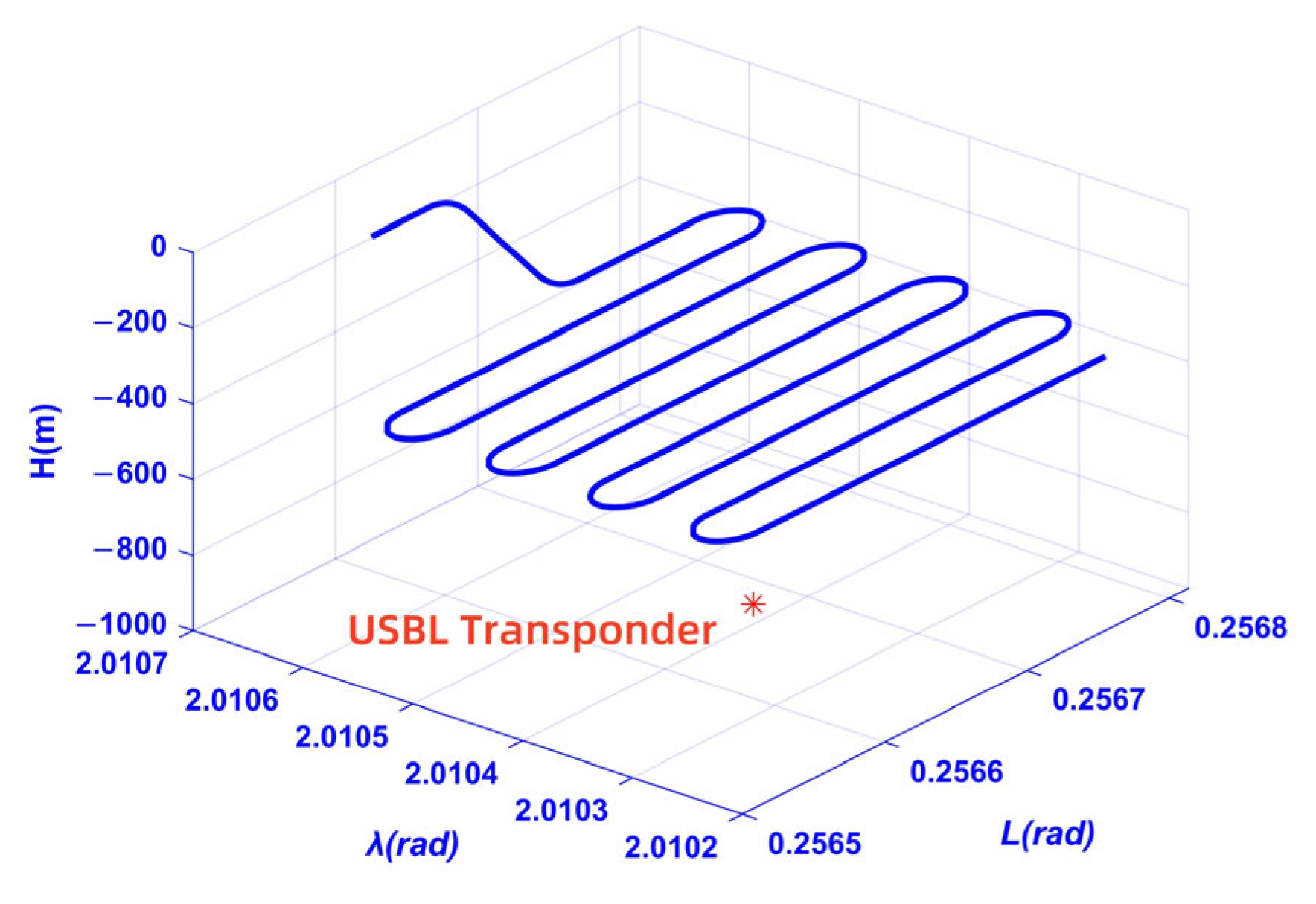
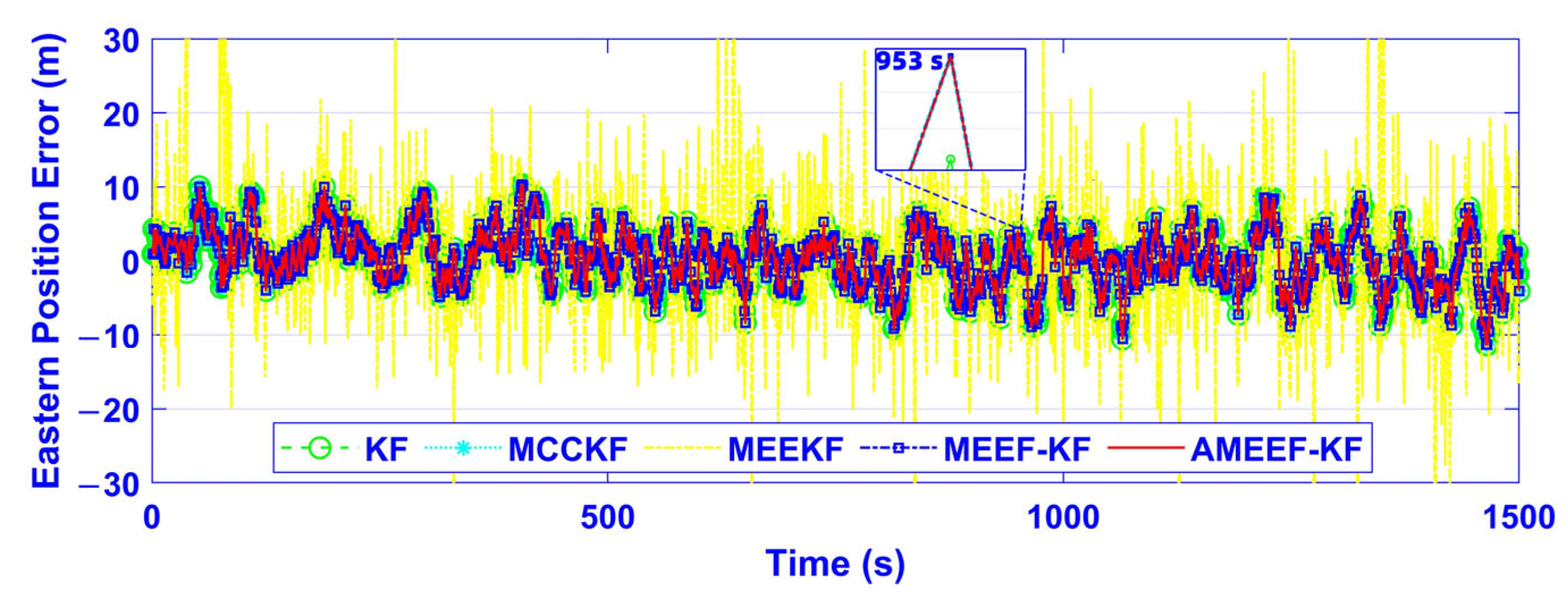
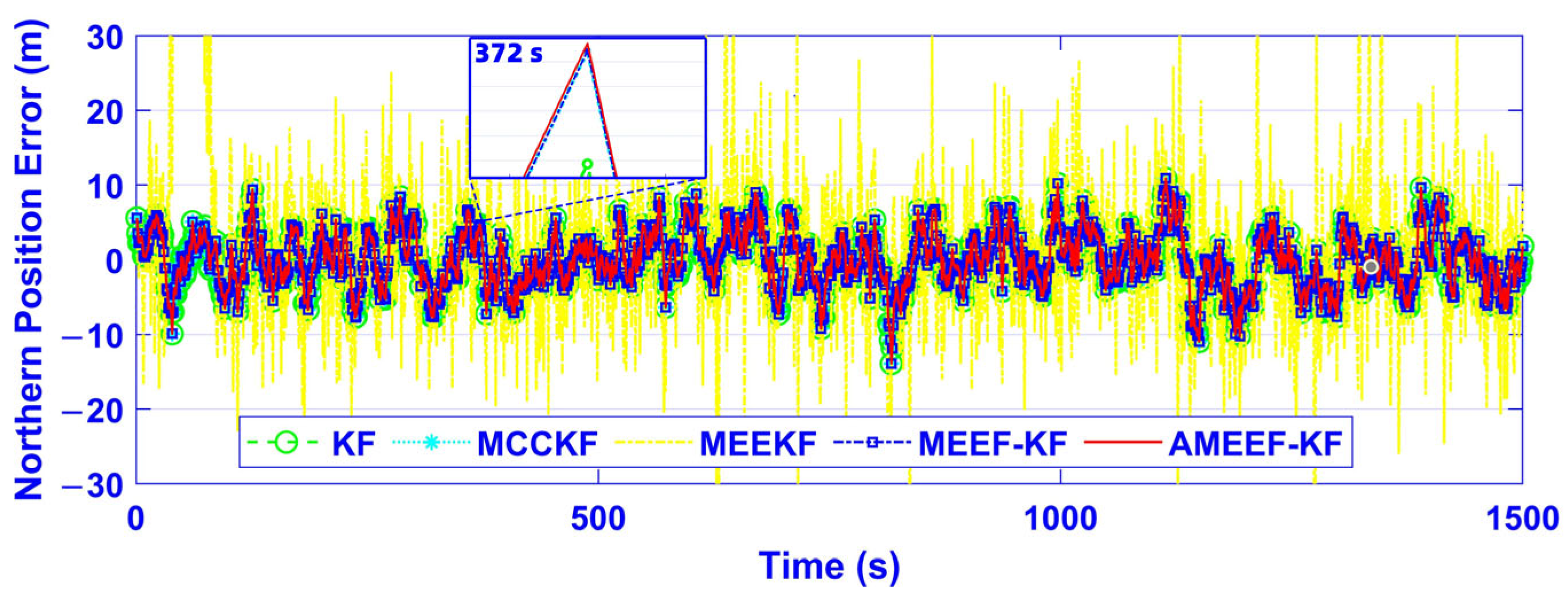
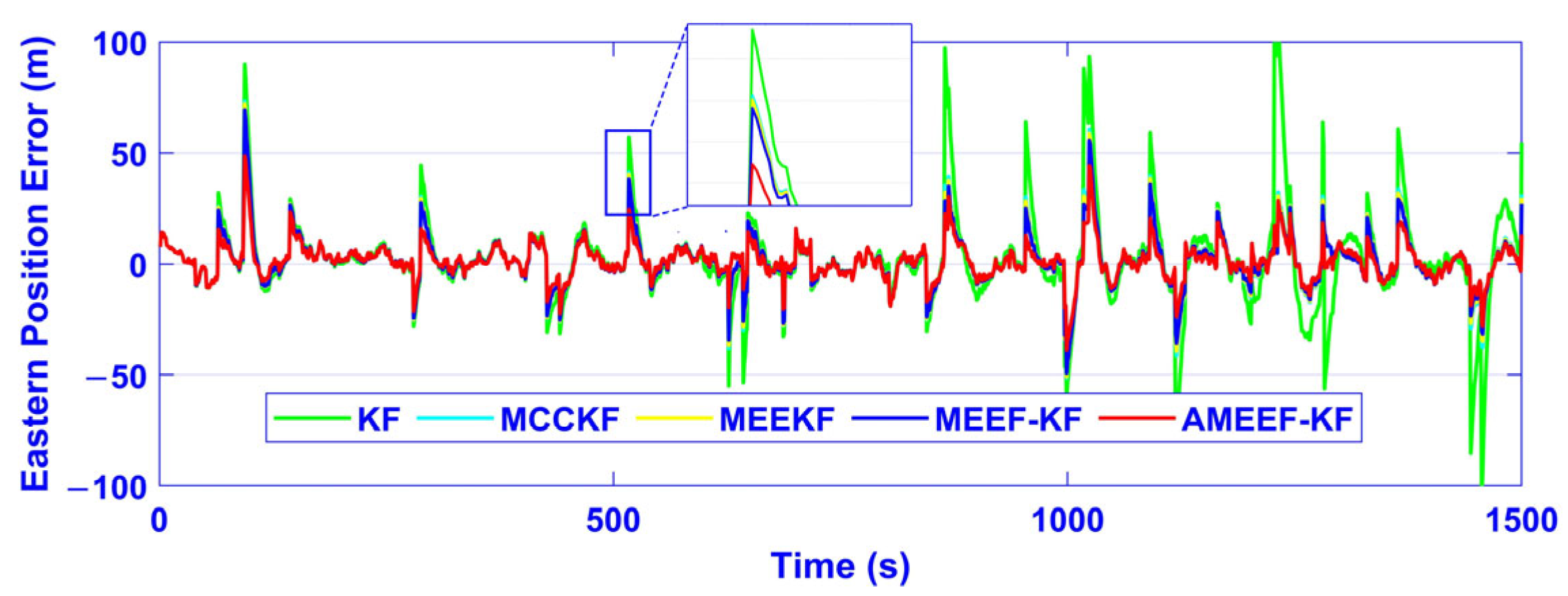

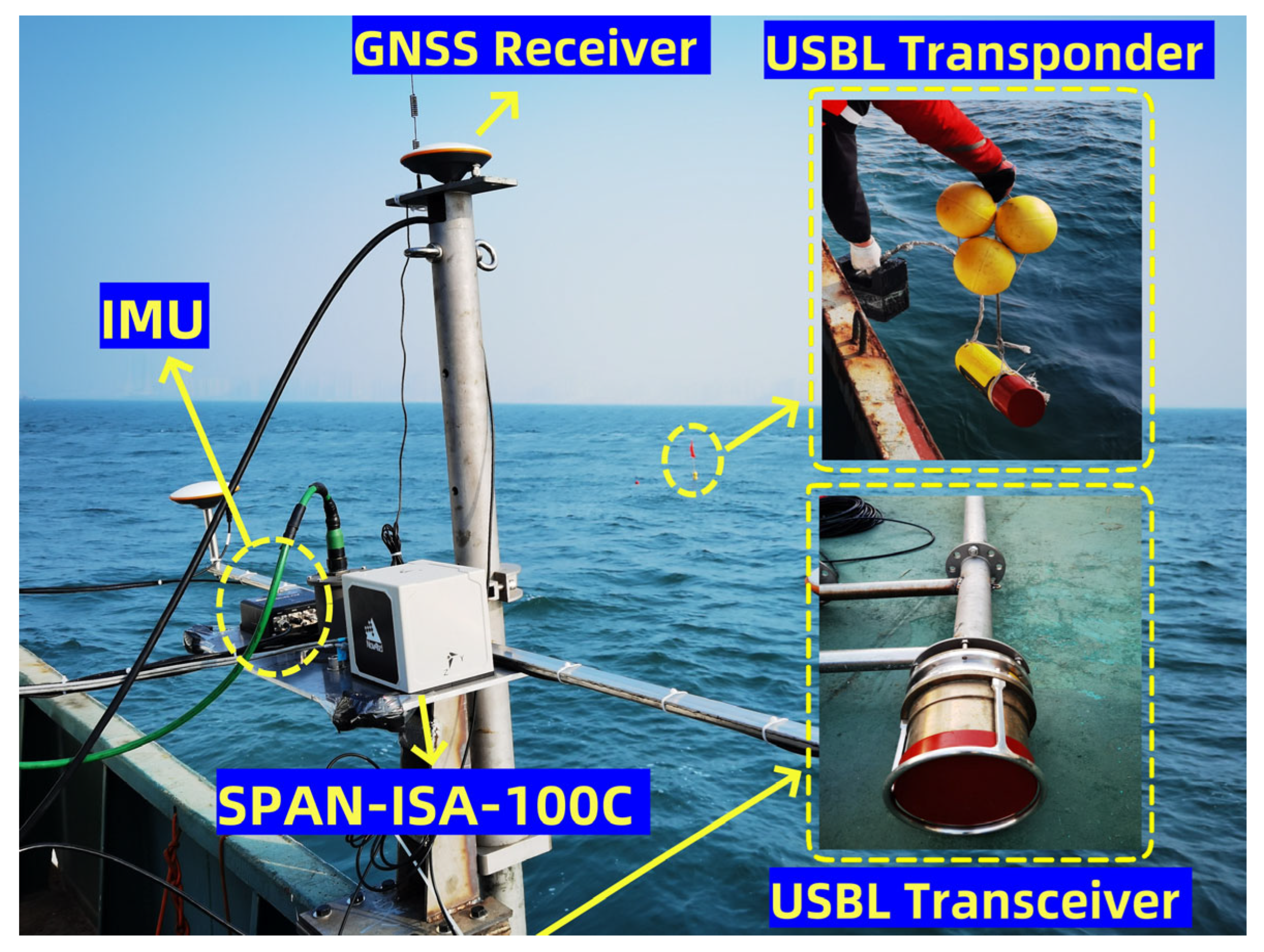

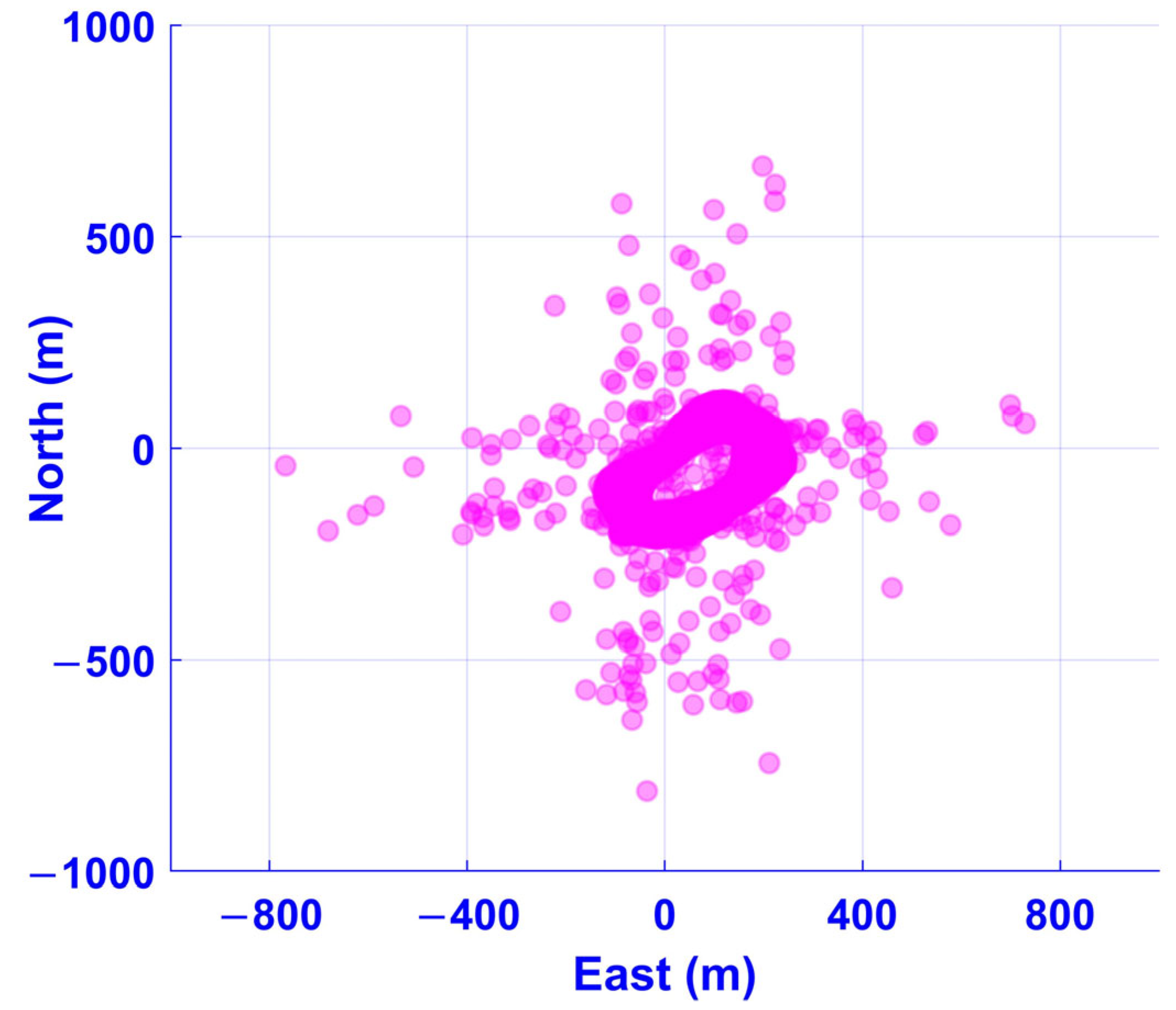
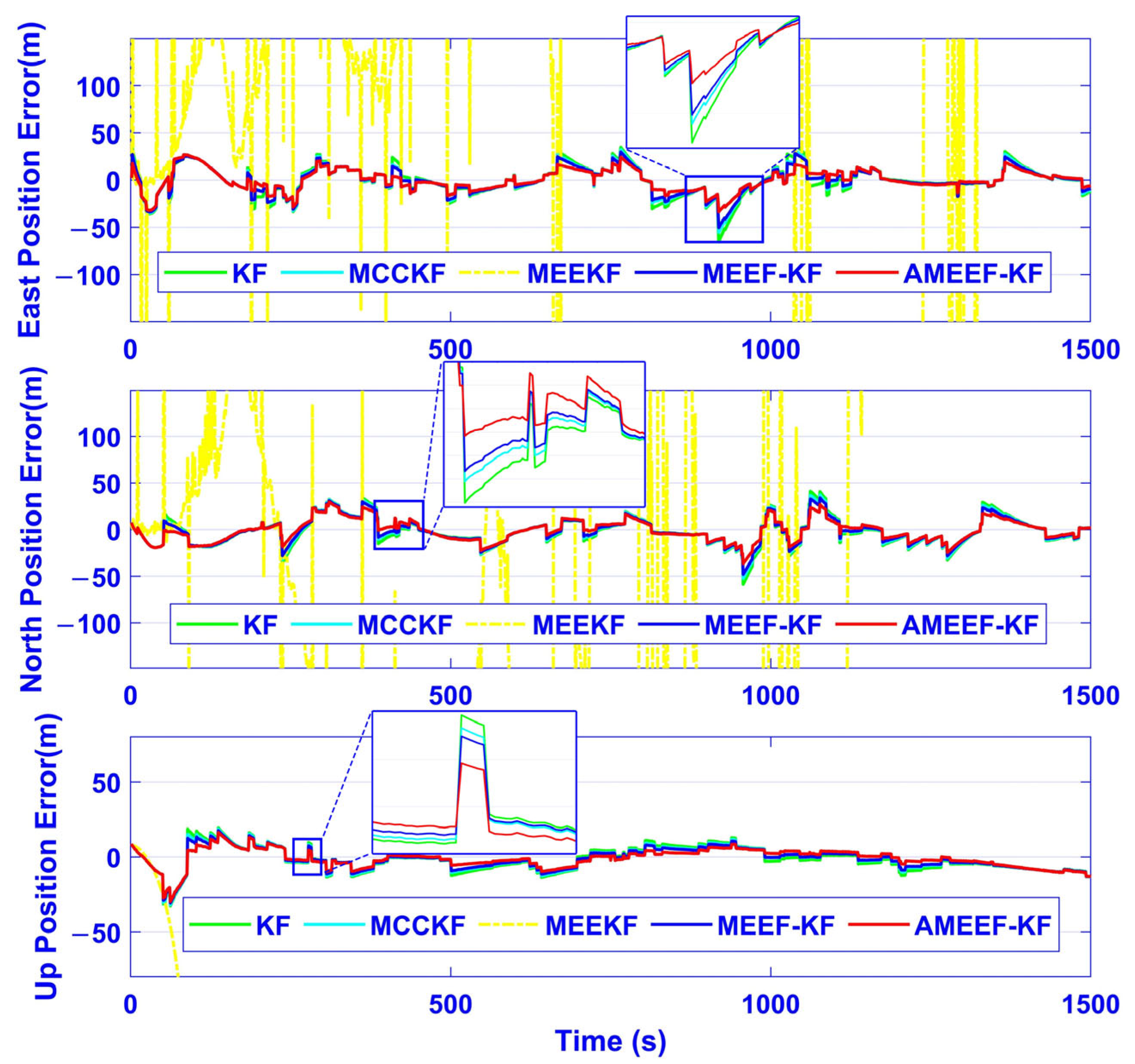
| Sensors | Parameter | Value |
|---|---|---|
| IMU | Random noise in gyro | 0.01°/h1/2 |
| Constant drift of gyro | 0.05°/h | |
| Random noise in accelerometer | 100 μg/h1/2 | |
| Constant bias of accelerometer | 0.1 mg | |
| USBL | Constant drift of USBL | 0.5% × Slant range |
| Random noise of USBL | 3 m | |
| Initial error | Initial position error | 9 m |
| Initial velocity error | 0.1 m/s | |
| Initial horizontal attitude error | 30′′ |
| KF | MCCKF | MEEKF | MEEF-KF | AMEEF-KF | ||||
|---|---|---|---|---|---|---|---|---|
| - | σ | σ | λ | σ1 | σ2 | λ0 | σ0 | σmin |
| - | 30 | 30 | 0.9 | 30 | 30 | 0.9 | 30 | 15 |
| Filtering Algorithm | East ARMSE (m) | North ARMSE (m) |
|---|---|---|
| KF | 3.7453 | 3.5440 |
| MCCKF | 3.7456 | 3.5448 |
| MEEKF | 11.2364 | 11.7799 |
| MEEF-KF | 3.7454 | 3.5441 |
| AMEEF-KF | 3.7454 | 3.5441 |
| Filtering Algorithm | East ARMSE (m) | North ARMSE (m) |
|---|---|---|
| KF | 20.6289 | 21.4342 |
| MCCKF | 11.6084 | 11.0833 |
| MEEKF | 11.2552 | 10.7322 |
| MEEF-KF | 10.6727 | 10.1434 |
| AMEEF-KF | 8.2994 | 7.7308 |
| Sensors | Parameter | Value |
|---|---|---|
| IMU | Random noise in gyro | 0.01°/h1/2 |
| Constant drift of gyro | 0.05°/h | |
| Random noise in accelerometer | 100 μg/h1/2 | |
| Constant bias of accelerometer | 0.1 mg | |
| Sampling frequency of IMU | 200 Hz | |
| USBL (Kongsberg μPAP) | Constant drift of USBL | 0.5% × Slant range |
| Random noise of USBL | 3 m | |
| Sampling frequency of USBL | 1 Hz | |
| Initial error | Initial position error | 9 m |
| Initial velocity error | 0.1 m/s | |
| Initial horizontal attitude error | 30″ | |
| Initial heading error | 30′ |
| Filter Schemes | East RMSE (m) | North RMSE (m) | Up RMSE (m) |
|---|---|---|---|
| KF | 13.3726 | 13.7601 | 10.4809 |
| MCCKF | 11.8538 | 12.8465 | 10.2193 |
| MEEKF | 1.6855 × 104 | 1.3108 × 104 | 5.9684 × 104 |
| MEEF-KF | 11.0102 | 11.8840 | 9.9075 |
| AMEEF-KF | 8.9214 | 10.4060 | 9.5613 |
Disclaimer/Publisher’s Note: The statements, opinions and data contained in all publications are solely those of the individual author(s) and contributor(s) and not of MDPI and/or the editor(s). MDPI and/or the editor(s) disclaim responsibility for any injury to people or property resulting from any ideas, methods, instructions or products referred to in the content. |
© 2025 by the authors. Licensee MDPI, Basel, Switzerland. This article is an open access article distributed under the terms and conditions of the Creative Commons Attribution (CC BY) license (https://creativecommons.org/licenses/by/4.0/).
Share and Cite
Wang, B.; Wang, Z. Adaptive Kalman Filter Under Minimum Error Entropy with Fiducial Points for Strap-Down Inertial Navigation System/Ultra-Short Baseline Integrated Navigation Systems. J. Mar. Sci. Eng. 2025, 13, 990. https://doi.org/10.3390/jmse13050990
Wang B, Wang Z. Adaptive Kalman Filter Under Minimum Error Entropy with Fiducial Points for Strap-Down Inertial Navigation System/Ultra-Short Baseline Integrated Navigation Systems. Journal of Marine Science and Engineering. 2025; 13(5):990. https://doi.org/10.3390/jmse13050990
Chicago/Turabian StyleWang, Boyang, and Zhenjie Wang. 2025. "Adaptive Kalman Filter Under Minimum Error Entropy with Fiducial Points for Strap-Down Inertial Navigation System/Ultra-Short Baseline Integrated Navigation Systems" Journal of Marine Science and Engineering 13, no. 5: 990. https://doi.org/10.3390/jmse13050990
APA StyleWang, B., & Wang, Z. (2025). Adaptive Kalman Filter Under Minimum Error Entropy with Fiducial Points for Strap-Down Inertial Navigation System/Ultra-Short Baseline Integrated Navigation Systems. Journal of Marine Science and Engineering, 13(5), 990. https://doi.org/10.3390/jmse13050990






